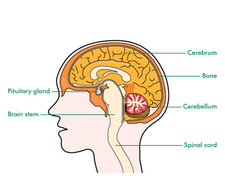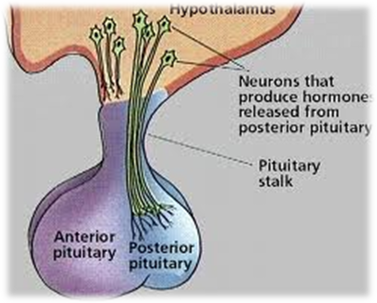
What is it that differs in structure, shape and size of the individuals? What stimulates the birth of an infant? What is it that maintains a balance in the body? What triggers the beauty in the human body? What nurtures the growth of a child? It is the Pituitary Gland that controls the functions in the body and is hence the conductor of the endocrine orchestra.
The Pituitary Gland is a small gland which lies to the base of the brain. It is an endocrine gland that is located to the centre of the skull, behind the bridge of the nose. It is about same the size of the pea and is an important channel between the nervous system and the endocrine system. It is also called as hypophysis, which means ‘to grow beneath’ and is considered as the master gland as it stimulates all the other glands of the body. Just above the Pituitary Gland is the hypothalamus, which is a tiny cluster of brain cells that transmits messages from the body to the brain.

The Pituitary Gland is enclosed in a protective bone called the sella turcica. Its structure is composed of two lobes, namely, the anterior, the intermediate and the posterior.
Anterior: The Rathke’s pouch is formed when the Pituitary Gland arises from the cavity that is formed of the oral ectoderm. On the contrary, the posterior pituitary originates from the neuroectoderm. The endocrine cells are regulated by the hormones that are released in the hypothalamus. The cells that release the anterior pituitary are the parvocellular neurosecretory cells that again release the hormones into the capillaries, which results in infundibular blood vessels, leading to a second capillary bed. This constitutes a relationship known as the hypothalamo-hypophyseal portal system. However, the Anterior Pituitary is further divided into pars tuberalis, pars intermedia and pars distails.
Posterior: This lobe is an extension of the hypothalamus. The cell bodies that are located in the hypothalamus are possessed by the magnocellular neurosecretory cells and projects down the infundibulum in the posterior pituitary.
Intermediate: It is often considered as a part of the anterior pituitary and is located between the anterior and the posterior. Generally, it is not well developed in tetrapods.

The primary function of the Pituitary Gland is to secrete hormones that regulate the control of the other body processes, such as:
-
Growth (both mentally and physically)
-
To maintain normal blood pressure
-
To stimulate the uterine contractions during childbirth
-
Produce breast milk
-
Function the sex organs of both the male and the female bodies
-
Function the thyroid gland Convert the food into energy To regulate the water and osmolarity in the body
-
Reabsorb the water by the kidneys
-
Regulate the temperature
-
Act as a pain relief

The most powerful organ in the human body is the Pituitary Gland as they remain active even after 50 years of age. One of the important responsibilities of the Pituitary Gland is to regulate the working and functioning of all the other glands in the body in order to make hormones. Though being a master gland of the body, it is controlled by the hypothalamus. Its significance stretches to the extent of the delivery of the child to its growth and development.
The diseases due to the malfunctioning of the Pituitary Glands are:
Hyperpituitarism: This happens when the secretion exceeds the normal production of hormones by the Pituitary Gland.
Hypopituitarism: Contrary to Hyperpituitarism, it is the decreased quantity of the secretion of hormones that is normally produced by the Pituitary Gland. Another term used for this is panhypopituitarism.
Pituitary Tumours: These are cancerous tumours.
Pituitary Adenomas: These are non-cancerous tumours.
G Kowledge of | 0 Comments >>
0 Comments
Leave Comment
Your email address will not be published. Required fields are marked.